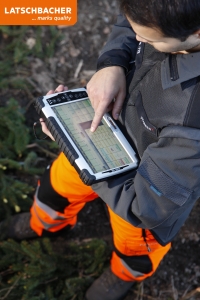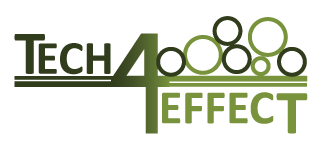T4E app developer tells us about developing app prototypes with European scientists
Michael Viertbauer from Latschbacher says the speed of forestry digitalisation could progress much quicker than it is currently.
TECH4EFFECT (T4E) technology partner, Austrian forest logistics company Latschbacher has provided innovative solutions for the forest industry for over 50 years. As market leader in mobile data acquisition apps in the German-speaking world, Latschbacher provided targeted technical and specialist support for key exploitable results across the project working closely with scientific partners to develop user-friendly apps which were tested in an operational setting.
In collaborative efforts with partners Latschbacher programmed the Bucking App, the Mapping App and the Tracking App — which is currently being tested for the uploading of machine data for the SILVISMART efficiency portal.
TECH4EFFECT Communications asked Michael Viertbauer from Latschbacher about his involvement in the project.
Tell us about the latest app, the Tracking App.

Austrian forest logistics company Latschbacher has provided innovative solutions for the forest industry for over 50 years.
The Tracking App is an innovative method of sharing movement and production data from harvesters and forwarders with other partners outside of the closed systems of the machine manufacturers.
Through the track that the machine creates on the map and the production quantities recorded by the harvester and forwarder, the progress of the timber harvesting production data will be able to be documented daily for potential data exchange between consenting parties.
With the data exchange formats, the client can send the stand-related data from the machines to SILVISMART.
But it is important that undesired data is not passed onto non-consenting parties. The forestry industry consists of many different entrepreneurs who have various interests depending on whether the person is a forest owner, contractor or even a logistics partner.
So, to make this data more powerful, it needs to be analysed and even compared with other forest operations which would mean sharing the data. For this to happen, agreements would need to be made between parties to share data on sensitive issues such as pricing, or even sharing the production volumes harvested over time.
Forest actors need to trust each other before they can share data with each other. Data sharing in Nordic countries is much more open than in Central Europe.
To bring the functions of the Tracking App into broader commercial use, it would be necessary to expand the data exchange which belongs to SILVISMART, to include forest data exchange formats (for example, ELDAT in Germany or FHPDATLOG in Austria). With the data exchange formats, the client can send the project-related data to the machines, which then report back the production data to consenting parties.
Furthermore, depending on the forest ownership structure, forest owners, timber harvesters and transporters are often different entrepreneurs. When exchanging data, it is important to take into account the wishes of the individual participants in order not to pass on undesired data that should remain within a company to partners.
Working with scientists to provide specific solutions to problems that have never been solved, or even thought of, presents an opportunity for companies like Latschbacher to introduce new technologies to their daily work. This experience is important for the further development of existing products and the conception of new applications — Viertbauer.
Latschbacher is amongst Austria’s leading forest equipment suppliers. How do you see the forestry sector being digitalised? Will this happen quickly?
We notice that digitization is progressing moderately. The technology is not the problem — all the necessary tools already exist. From a technical point of view, the speed of forestry digitisation could progress much faster than it is currently.
However, new software tools are usually accompanied by changed processes. Establishing these processes in the work procedures and introducing them with partner companies and employees is usually the limiting factor. This especially is the case when it comes to data exchange between several companies. We also have noticed that the openness to digital solutions varies greatly between individual regions and countries.
How easy is it to keep pace of digital change when developing software for forestry?
Due to the rapid progress of digitalisation, especially in the mobile area, where new operating system versions are released every year, the need to continuously adapt all applications has increased significantly. We keep our development tools permanently up to date. This ensures that we can deliver products and updates that are compatible with the latest systems at any time. But the challenge is to decide for how long that you will continue to support old systems with technical updates and support.
Do foresters see the benefits of apps, other digital solutions that Latschbacher is developing?
Of course. Our philosophy is that only those products which the customer sees as being beneficial are those which are developed, and then are considered successful. Sometimes, it is important to point out the benefits of what the apps can provide to the customers or target group because it can be that not all the advantages of a digital tool are recognized at first.
Talk us through some of the processes that are involved in developing prototype apps.
We use agile development to ensure that any necessary changes in the direction of what is needed can be incorporated afterwards because some of the solutions are not always visible at first. In the beginning the user interface design is discussed and then the logic can be incorporated into the application step-by-step.
In between, a version is delivered in regular feedback loops, which is discussed with all relevant parties. Thus, the customer is constantly involved as the solution is being created and he or she is sure to get the result that meets the necessary design requirements. This is a big advantage, working closely with the customer, especially with prototypes, as you can react to changes in development.
Software has so many advantages, but convincing people to use digital tools is challenging. Sometimes people are afraid to use digital tools because they believe that they have more control over paperwork. For example they are afraid to lose digital information and data, and may even find updating digital tools a challenging task. But in reality, digital tools always improve the speed and reliability of the process in the end — Viertbauer.
Do you think the forestry sector is ready for digitalisation considering that many of the experienced workers are older?
Yes. Digitization is not about the age of the person but about the willingness to accept new things: we have users who have learned to use the most modern tools one year before retiring.
What is one of the most frustrating aspects of continuously developing new software?
Usually, software is developed to present a solution often due to an associated problem that needs to be specifically solved within the organizational and, or personal setting. Often, the software then can be seen as an undesired interference, or as a controlling factor in a work process, which really is related to an organisational, or managerial change. In this context, if someone does not want to use a tool there are always reasons that speak against it.
What motivates you the most, personally, in developing Apps?
The drive to identify problems and to find technical solutions for them, as well as to see the improvement after the introduction of an app. It is rewarding when you find that work, or a work process, would be unimaginable without the app that you’ve just developed. That is confirmation that you have done a good job.
This project has received funding from the Bio Based Industries Joint Undertaking under the European Union’s Horizon 2020 research and innovation programme under grant agreement No 720757.



